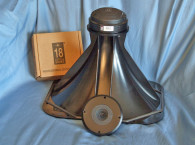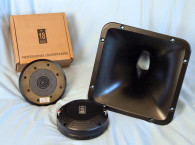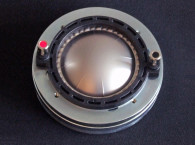




Following the acquisition, Voice Coil hasn’t featured any of the new products from Eighteen Sound, so it’s great to welcome them back! Eighteen Sound sent one of its latest 1” compression driver designs, the ND1TP, along with its XT120 elliptical-shaped horn (Photo 1).
Designed for use with 1” throat horns, the ultracompact ND1TP compression driver has a 25mm (1”) throat diameter driven by a 44mm (1.75”) diameter edge-wound voice coil wound with copper-clad aluminum wire (CCAW) on a non-conducting Nomex former with a proprietary treatment.
This specially treated Nomex former shows a 30% higher value of tensile elongation at operating temperatures (200°C) when compared to Kapton. This assembly drives the titanium diaphragm and the PEN surround. The ND1TP also incorporates a proprietary phase plug design that has short openings and a high flare rate that, according to the company, reduces distortion and improves mid-range detail.
Other features include a computer-optimized neodymium magnet motor structure, a copper pole piece shorting ring (Faraday shield), with a continuous power handling of 100W and a 50 W nominal power handling rating, a 1.6kHz recommended crossover frequency (with a minimum 12dB/octave high-pass network), a corrosion resistant coating on the magnet and plates, and a 2.83V/1m 110dB sensitivity. Along with the ND1TP, Eighteen Sound provided the 1” XT120 90° x 60° elliptical horn with a 1.5kHz cutoff frequency. Made from high-pressure injection-molded polyurethane foam, the XT120 has a smooth flare rate that provides constant directivity from 2.5kHz.




Testing commenced using the LinearX LMS analyzer to produce the 300-point stepped sine wave impedance plot shown in Figure 1. The solid black curve represents the ND1TP mounted on the XT120 horn and the dashed blue curve represents the compression driver without the horn. With a nominal 8Ω impedance, the ND1TP has a 5.17Ω DCR, with minimum impedance mounted on the XT120 horn of 6.68Ω and at 6.24 kHz.
For the first set of SPL measurements, I free-air mounted the ND1TP/XT120 combination without an enclosure and measured both the horizontal on- and off-axis at 2.0V/0.5m (normalized to 2.83V/1m) from 0° on-axis to 60° off-axis using the LoudSoft FINE R+D analyzer and GRAS 46BE microphone (supplied courtesy of LoudSoft and GRAS Sound & Vibration).
Figure 2 displays the on-axis frequency response of the ND1TP/XT120 combination, which is relatively smooth ±2dB response up to 5.5kHz with no major anomalies below 20kHz. Figure 3 shows the 0° to 60° on- and off-axis response in the horizontal plane. Figure 4 displays the normalized horizontal plane response. Figure 5 shows the 180° horizontal polar plot (in 10° increments with 1/3 octave smoothing applied) generated by the CLIO Pocket analyzer and accompanying microphone (courtesy of Audiomatica SRL). For the vertical plane, Figure 6 depicts the 0° to 60° on- and off-axis response with the normalized version shown in Figure 7.
Figure 8 shows the CLIO-generated the 180° vertical polar plot (also measured in 10° increments with1/3 octave smoothing applied). Last, Figure 9 gives the two-sample SPL comparison showing the two Eighteen Sound ND1TP compression driver samples to be closely matched within 1dB or less above the recommended crossover frequency 15kHz, with somewhat greater variation above that, which is why most QC windows are wider above 10kHz.




For the remaining series of tests, I set up the Listen, Inc. AudioConnect analyzer and 1/4” SCM microphone (provided by Listen, Inc.) to measure distortion and generate time-frequency plots. For the distortion measurement, I again mounted the ND1TP/XT120 combination in free-air in the same manner as was used for the frequency response measurements.
I set the SPL to 104dB at 1m (2.12V), determined by using a pink noise stimulus generator and internal SLM in the SoundCheck 18 software), and then measured the distortion with the Listen microphone placed 10cm from the mouth of the horn. This produced the distortion curves shown in Figure 10. Note the extremely low third harmonic level.
Following this test sequence, I then set up SoundCheck 18 to generate a 2.83V/1m impulse response curve for the ND1TP/XT120 combination and imported the data into Listen’s SoundMap Time/Frequency software. Figure 11 shows the resulting cumulative spectral decay (CSD) waterfall plot. Figure 12 provides the Short Time Fourier Transform (STFT) plot.
After reviewing all the objective measurement data, I found that the Eighteen Sound ND1TP compression driver is obviously a well-engineered 1” compression driver, exhibiting good performance, great build quality, and featuring a number of proprietary enhancements. For more information about this and other Eighteen Sound OEM pro sound products, visit www.eighteensound.com. VC
This article was published in Voice Coil, April 2021.







